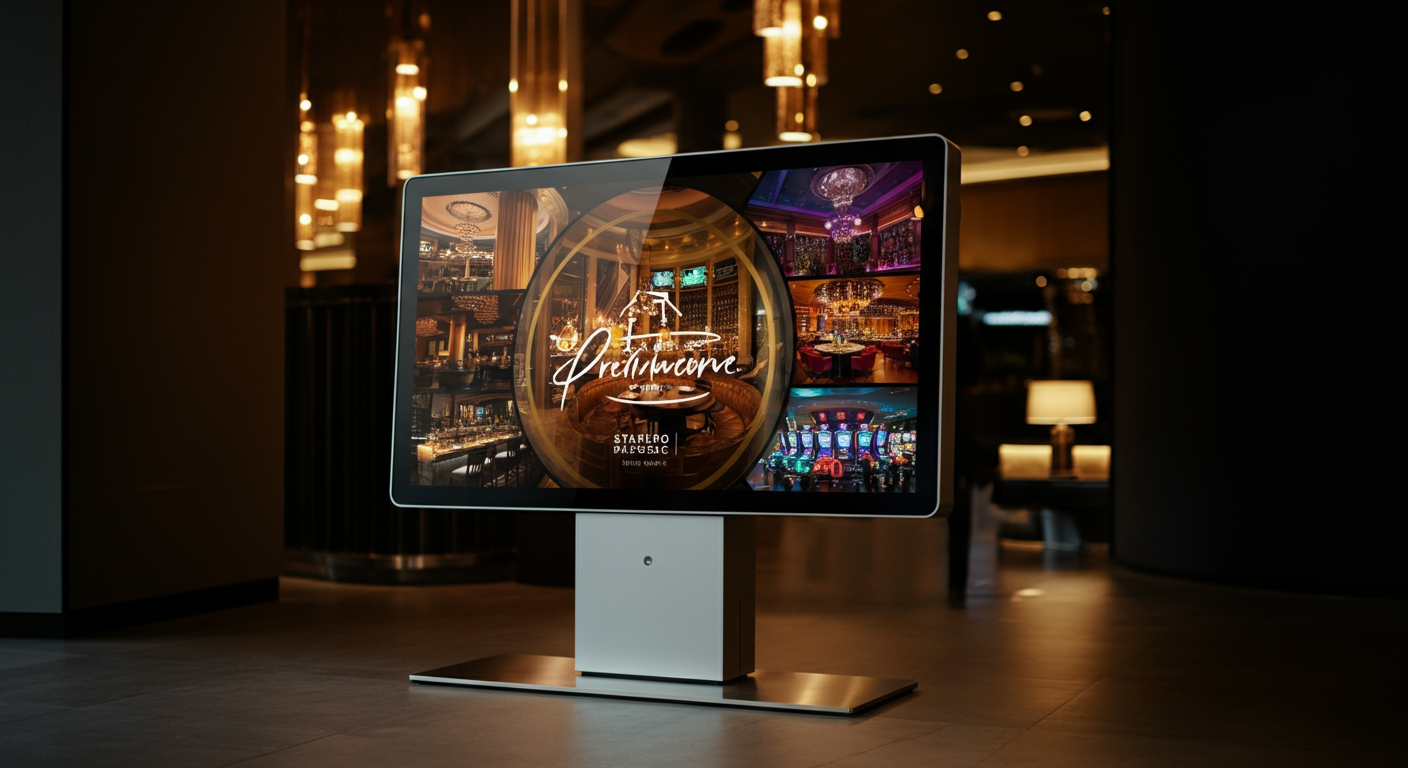In today’s competitive business landscape, maintaining a consistent brand image across multiple locations is crucial for success. This is where Digital Signage Solutions for Multi-Location Businesses come into play. Imagine walking into your favorite chain restaurant and experiencing the same engaging atmosphere and information regardless of the location. That’s the power of unified digital signage!
For businesses in the hospitality and entertainment industries, such as casinos, restaurants, and bars, creating a cohesive brand presence is essential. It’s not just about displaying content; it’s about crafting an experience that resonates with customers and enhances their overall visit. By implementing digital signage solutions, multi-location organizations can ensure centralized control over their messaging, providing a seamless and engaging experience for their customers.
DLM Media understands the unique challenges faced by businesses operating across various locations. With their expertise in commercial video programming solutions, they offer a consultative approach to deliver high-quality content and reliable signal delivery. This ensures that every customer enjoys a hassle-free and immersive experience, no matter where they are.
In this blog post, we’ll explore how digital signage can unify your branding efforts, boost customer engagement, and streamline operations across all your business environments. From tips on choosing the right hardware to strategies for content management, we’ll guide you through the essential steps to achieve a successful multi-location digital signage strategy.
Ready to transform your business with digital signage? Let’s dive into the world of digital solutions that make a difference in customer experience and brand consistency.
Benefits of Digital Signage for Multi-Location Businesses
In today’s fast-paced business environment, maintaining a consistent brand image across multiple locations is crucial. Digital Signage Solutions for Multi-Location Businesses offer a powerful tool to achieve this goal. By leveraging digital signage, businesses can ensure uniform branding, enhance customer engagement, and streamline content management across all locations.
Competitors like ComQi highlight that digital signage can significantly improve customer experience and drive sales by delivering dynamic and relevant content. Let’s explore the specific benefits that digital signage brings to multi-location businesses.
Consistent Branding Across Locations
One of the primary advantages of digital signage is its ability to maintain consistent branding across all business locations. This uniformity helps in building a strong brand identity, which is essential for customer recognition and loyalty. By using digital signage, businesses can display the same logos, color schemes, and messaging at each location, ensuring that customers have a cohesive experience no matter where they are.
For instance, a chain of restaurants can use digital menus that not only display the same items but also highlight the brand’s unique selling points. This consistency reinforces the brand image and enhances customer trust.
Enhanced Customer Engagement
Digital signage is an effective tool for increasing customer engagement. By displaying dynamic content such as videos, animations, or interactive elements, businesses can capture customer attention and encourage interaction. This is particularly beneficial in industries like hospitality and entertainment, where engaging customers is key to enhancing their experience.
According to a study by ComQi, businesses that implement digital signage see a noticeable increase in customer engagement and satisfaction. By tailoring content to the specific interests of their audience, businesses can create a more personalized and memorable experience.
Flexibility in Content Management
Managing content across multiple locations can be challenging, but digital signage offers a flexible solution. With a centralized content management system (CMS), businesses can easily update and control the content displayed at each location. This ensures that all locations are aligned with the latest promotions, announcements, or branding changes.
For example, a retail chain can quickly update its digital displays to reflect seasonal promotions or new product launches. This flexibility not only saves time but also ensures that all locations are consistently delivering the most relevant content to their customers.
In conclusion, digital signage provides multi-location businesses with the tools they need to maintain consistent branding, enhance customer engagement, and streamline content management. As businesses continue to expand and adapt to changing market demands, digital signage will remain a vital component of their strategy. To explore more about how digital signage can benefit your business, visit DLM Media for expert insights and solutions.
Choosing the Right Digital Signage Solutions
When it comes to Digital Signage Solutions for Multi-Location Businesses, selecting the right tools can make all the difference in maintaining a cohesive brand image. The decision involves more than just picking a screen; it requires a strategic evaluation of hardware, software, and content management systems (CMS) that align with your business goals. With competitors like ComQi and Wallboard setting high standards, understanding these elements is crucial for success.
Businesses need to consider factors such as scalability, integration capabilities, and user-friendliness. The right digital signage solution should not only meet current needs but also adapt to future expansions. Let’s explore the key criteria for choosing the best digital signage solutions and compare some popular platforms in the market.
Evaluating Hardware Options
Choosing the right hardware is a foundational step in deploying digital signage across multiple locations. Consistency in hardware ensures that each location delivers the same brand experience. According to Wallboard, using uniform hardware across all sites helps build better brand awareness and creates a unified customer experience.
Consider the following when evaluating hardware options:
- Compatibility: Ensure that new hardware integrates seamlessly with existing systems.
- Scalability: Select hardware that can grow with your business needs.
- Durability: Opt for robust and reliable hardware that can withstand different environmental conditions.
For instance, if your business operates in both indoor and outdoor environments, you might need screens that can handle varying light and weather conditions. This strategic choice will save time and resources in the long run.
Choosing the Right Software and CMS
The software and CMS you select will be the backbone of your digital signage network. A cloud-based CMS, like those offered by Wallboard and ComQi, provides flexibility and ease of management across multiple locations. These systems allow for real-time updates and centralized control, which is essential for maintaining consistent messaging.
When evaluating software options, consider:
- Ease of Use: The platform should be user-friendly for both content creators and managers.
- Integration: Ensure the CMS can integrate with other business systems and applications.
- Scalability: The ability to add more users and devices as your network grows is crucial.
ComQi’s EnGage platform, for example, offers a comprehensive solution with features like remote system monitoring and custom APIs for data integration, making it a strong contender for businesses seeking a robust digital signage solution.
Comparing Popular Platforms
To help you make an informed decision, here’s a comparison of some leading digital signage platforms:
| Platform | Key Features | Best For |
|---|---|---|
| Wallboard | Cloud-based CMS, user-friendly interface, drag-and-drop content creation | Businesses looking for flexibility and ease of use |
| ComQi | End-to-end turnkey solutions, remote monitoring, custom APIs | Enterprises needing comprehensive and scalable solutions |
| ScreenCloud | Remote device management, robust app integrations | Companies seeking seamless integration with existing systems |
Each platform offers unique advantages, so it’s important to assess which aligns best with your business objectives and operational needs. By carefully evaluating these options, you can ensure that your digital signage strategy enhances your brand’s presence across all locations.
Implementing a Successful Digital Signage Strategy
Creating a successful digital signage strategy is essential for businesses aiming to unify their brand across multiple locations. A well-executed strategy not only enhances brand consistency but also boosts customer engagement and operational efficiency. To achieve this, businesses must focus on several key areas, including content relevance, audience engagement, and regular updates. Competitors like ScreenCloud and ComQi offer valuable insights into effective strategy implementation, which we will explore in this section.
Let’s delve into the actionable steps necessary to implement a successful digital signage strategy for multi-location businesses.
Step-by-Step Guide to Strategy Implementation
Implementing a digital signage strategy requires a structured approach. Here’s a step-by-step guide to help you get started:
- Define Clear Objectives: Begin by identifying what you aim to achieve with your digital signage. Whether it’s increasing sales, enhancing brand awareness, or improving customer experience, having clear objectives will guide your strategy.
- Select the Right Technology: Choose hardware and software that align with your business needs. Consistency in technology across locations ensures a uniform brand experience. Consider cloud-based CMS solutions like those from Wallboard for flexibility and ease of management.
- Create Engaging Content: Develop content that resonates with your audience. Tailor your messages to the specific needs and interests of each location. Utilize dynamic content, such as videos and interactive elements, to capture attention.
- Schedule Regular Updates: Keep your content fresh by scheduling regular updates. Use analytics to determine the optimal times for content changes, ensuring relevance and engagement.
- Train Your Team: Ensure that your staff is well-trained in managing and troubleshooting digital signage systems. This will help in maintaining smooth operations and quick issue resolution.
The Role of Analytics in Measuring Success
Analytics play a crucial role in assessing the effectiveness of your digital signage strategy. By leveraging data, businesses can gain insights into audience engagement and content performance. Here’s how analytics can enhance your strategy:
- Audience Insights: Use analytics to understand viewer demographics and behavior. This data helps in tailoring content to better meet audience preferences.
- Content Performance: Evaluate which content formats and messages are most effective. Adjust your strategy based on performance metrics to optimize engagement.
- ROI Measurement: Track the return on investment by analyzing sales data and customer feedback. This will help in justifying the expenditure on digital signage systems.
By integrating analytics into your digital signage strategy, you can make informed decisions that enhance overall effectiveness and drive business success.
Actionable Steps for Continuous Improvement
To ensure ongoing success, businesses should focus on continuous improvement. Here are some actionable steps:
- Regularly Review Objectives: Periodically reassess your goals and adjust your strategy to align with evolving business needs.
- Stay Updated with Trends: Keep abreast of the latest digital signage trends and innovations to stay competitive.
- Seek Feedback: Gather feedback from customers and staff to identify areas for improvement. Use this information to refine your strategy.
By following these steps, businesses can implement a successful digital signage strategy that enhances brand consistency and customer engagement across multiple locations. For more insights on digital signage solutions, visit DLM Media.
Maximizing the Potential of Digital Signage
As we have explored, Digital Signage Solutions for Multi-Location Businesses offer a transformative approach for enhancing brand consistency and customer engagement. By strategically implementing these solutions, businesses can create a unified brand presence that resonates across all locations. This cohesive experience not only strengthens brand identity but also fosters customer loyalty, which is vital in today’s competitive market.
Digital signage provides businesses with unparalleled flexibility in content management. With the right content management system (CMS), businesses can easily update and tailor content to suit the specific needs and preferences of each location. This ensures that messaging remains relevant and engaging, ultimately leading to improved customer interaction and satisfaction. As highlighted, choosing the right digital signage hardware and software is crucial for scalability and integration, allowing businesses to adapt and grow effortlessly.
Key Takeaways
- Consistent Branding: Digital signage ensures uniform branding across multiple locations, enhancing customer recognition and trust.
- Enhanced Engagement: Dynamic content like videos and interactive elements capture customer attention and boost engagement.
- Flexible Management: A centralized CMS allows for easy content updates, ensuring all locations are aligned with current promotions and branding.
- Scalable Solutions: Choose hardware and software that can grow with your business needs and integrate seamlessly with existing systems.
To fully leverage the benefits of digital signage, it’s essential to continuously refine strategies based on analytics and customer feedback. By doing so, businesses can ensure that their digital signage solutions remain effective and impactful. We invite you to explore more about how digital signage can transform your business by visiting DLM Media. Our team of experts is ready to assist you in crafting a strategy that aligns with your brand’s unique needs.
Ready to take the next step? Embrace the power of digital signage and see the difference it can make in your customer experience and brand consistency. Share your thoughts or questions in the comments below, and let’s continue the conversation on how to enhance your business with innovative signage solutions.





